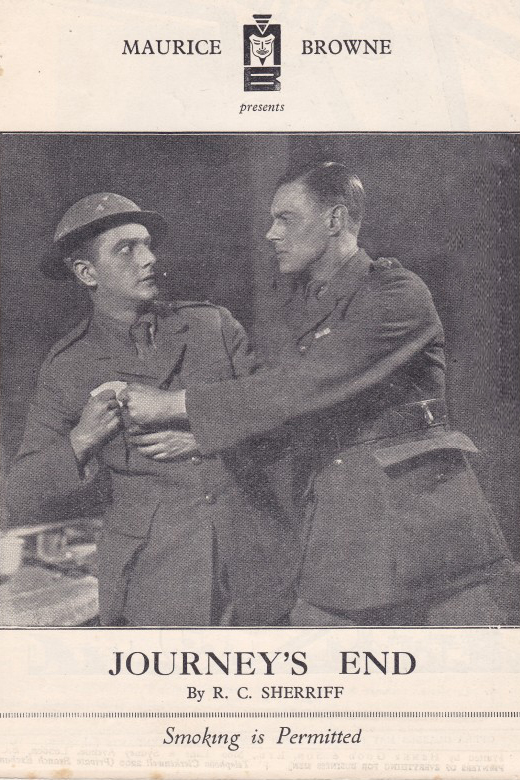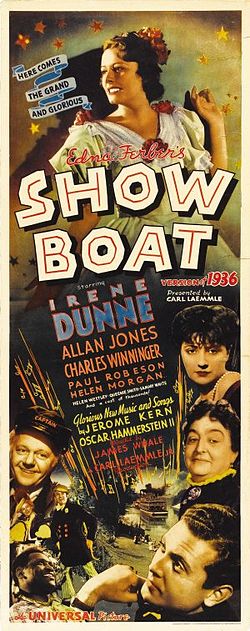Pas de biographie disponible.
Compositeur Musique additionelle Librettiste Parolier Metteur en scène Chorégraphe Producteur création Producteur version

Version 1
Journey's End (1928-12-Apollo Theatre-London)
Type de série: OriginalThéâtre: Apollo Theatre (Londres - Angleterre) Durée : Nombre : 2 représentationsPremière Preview : InconnuPremière : Sunday 09 December 1928Dernière : Monday 10 December 1928Mise en scène : James Whale • Chorégraphie : Producteur : Avec : David Horne (Captain Hardy), George Zucco (Lieutenant Osborne), Alexander Field (Private Mason), Maurice Evans (2nd Lieutenant Raleigh), Laurence Olivier (Captain Stanhope), Melville Cooper (2nd Lieutenant Trotter), Robert Speaight (2nd Lieutenant Hibbert), H. G. Stoker (The Colonel), Reginald Smith (The Company Sergeant Major), Geoffrey Wincott (A German Soldier), Richard Caldicot (Lance-Corporal Broughton)Commentaires : Il s'agit de la création mondiale de cette pièce, qui a donc lieu à l'Apollo Theatre de Londres avec un tout jeune acteur qui a de l'avenir, Laurence Olivier. Produite par la "Incorporated Stage Society", elle sera jouée dans d'autres théâtres du West End pendant deux ans…Commentaires longs: Under a new producer, Maurice Browne, the play soon transferred to the Savoy Theatre where it ran for three weeks starting on 21 January 1929. The entire cast from the Apollo reprised their roles (George Zucco playing Osborne and Maurice Evans Raleigh) except for Olivier, who had secured another role and was replaced by Colin Clive as Stanhope. The play then transferred to the Prince of Wales Theatre, where it ran for the next two years.

Version 2
Show Boat (1936-05-Film)
Type de série: FilmThéâtre: *** Film (*** - ***) Durée : Nombre : Première Preview : InconnuPremière : Sunday 17 May 1936Dernière : InconnuMise en scène : James Whale • Chorégraphie : Producteur : Avec : Irene Dunne / Allan Jones / Charles Winninger / Paul Robeson / Helen Morgan / Helen Westley / Queenie Smith / Hattie McDaniel / Donald Cook / Sammy WhiteCommentaires longs: The three new songs written by Kern and Hammerstein for the 1936 film are:
"I Have The Room Above Her" (a duet for Magnolia and Ravenal, sung in a new scene not included in the original play, but performed approximately in the spot in which the song I Might Fall Back On You was sung by Frank and Ellie, the comic dance team, in the show. "I Might Fall Back On You" is not sung in the film; a tiny fragment of it is heard instrumentally in the New Year's Eve sequence.) Harold Prince included "I Have the Room Above Her" in his 1993 stage revival of Show Boat.
"Gallivantin' Around" (a blackface number sung onstage by Magnolia, in place of the orchestral Olio Dance performed by Frank in the original play). An instrumental version of "Gallivantin' Around" is played in the film's new final scene.
"Ah Still Suits Me" (a comic duet for Joe and Queenie, written especially to expand both their roles, and sung in a new scene specially written for the film) This song was also included in the 1989 Paper Mill Playhouse stage revival of Show Boat, telecast by PBS.
Production history
This film version of Show Boat stars Irene Dunne as Magnolia and Allan Jones as Ravenal, with Charles Winninger, Paul Robeson, Helen Morgan, Helen Westley, Queenie Smith, Sammy White, Donald Cook, Arthur Hohl, and Hattie McDaniel. It was directed by Frankenstein / Bride of Frankenstein director James Whale, who tried to bring as many people from the stage production as he could to work on the film. Winninger, Morgan and White had all previously played their roles in both the original 1927 stage production and the 1932 stage revival of the musical. Robeson, for whom the role of Joe was actually written, had appeared in the show onstage in London in 1928 and in the Broadway revival of 1932. Dunne had been brought in to replace Norma Terris, the original Magnolia, in the touring version of the show, and had toured the U.S. in the role beginning in 1929. Francis X. Mahoney, who played the brief role of the comic stagehand "Rubber Face" Smith, had also starred in the original production and in the 1932 Broadway revival, and would repeat his role in the 1946 Broadway revival of Show Boat, two years before his death.
The 1936 film also enlisted the services of the show's original orchestrator, Robert Russell Bennett, and its original conductor, Victor Baravalle. The screenplay for the film was written by Hammerstein.
The songs were performed and staged in a manner very similar to the way they were done in the original stage version, not counting the three new songs written for the film, of course. Many of the show's original vocal arrangements (by an uncredited Will Vodery) were retained in the film. "Why Do I Love You?" had been filmed in a new setting - inside a running automobile - but was cut just before the film's release to tighten the running time. There is no word on whether or not this footage has survived.
Due to time constraints, Whale was forced to delete much of his ending sequence, including a "modern" dance number to contrast with the romantic, "Old South" production number we see Kim starring in, and which was intended to highlight African-American contributions to dance and music.
According to film historian Miles Kreuger in his book Show Boat: The History of a Classic American Musical, great care was taken by director James Whale to ensure a feeling of complete authenticity in the set and costume design for the 1936 film.
Reception
The 1936 version of Show Boat is considered by many film critics to be one of the classic film musicals of all time, and one of the best stage-to-film adaptations ever made. Frank S. Nugent of the New York Times called it "one of the finest musical films we have seen".
Ten numbers from the stage score are actually sung, with four others heard only as background music, and a tiny, almost unrecognizable fragment of the song "I Might Fall Back on You" is heard instrumentally at the beginning of the New Year's Eve sequence. Except for three new dialogue scenes, the final ten minutes of the film, and the three additional songs written for the movie by Kern and Hammerstein, the 1936 Show Boat follows the stage musical extremely closely, unlike the 1929 film and the 1951 version released by MGM. It is so faithful that even several instrumental pieces not by Kern which are regularly included as part of the show's score are retained in the film. [6] The film also retains much of the comedy in the show.
In 1996, this version of Show Boat was selected for preservation in the United States National Film Registry by the Library of Congress as being "culturally, historically, or aesthetically significant".
Temporary withdrawal from circulation
Show Boat was successful at the box office, but was withdrawn from circulation in the 1940s, after MGM bought the rights so that they could film their own Technicolor remake; however, MGM's version did not begin filming until 1950, and was released in the summer of 1951. The fact that Paul Robeson, who played Joe in the 1936 version, was blacklisted in 1950 further assured that the 1936 film would not be seen for a long time, and it was not widely seen again until after Robeson's death in 1976. In 1983 it made its debut on cable television, and a few years later, on PBS. It was subsequently shown on TNT and now turns up from time to time on TCM. It was made available on VHS beginning in 1990, but it has yet to be released on an authorized DVD, although a Brazilian company, Classicline, released a DVD version in 2003. For several years, Warner Brothers, through which Turner now releases its official DVDs, has been promising a comprehensive set of all three Show Boat films, but as of August 2012, this has still not come to pass, though there is a great demand for an official DVD release.
The Voyager Company, under its Criterion Collection Label, released two versions on laserdisc in 1989 of the 1936 version. One was a special edition with extras that included the history of show boats in general and its stage and film history, and the other was a movie only version. MGM/UA Home Video released the 1929, 1936 and 1951 versions, as well as the Show Boat sequence from Till the Clouds Roll By, as The Complete Show Boat collection on laserdisc in 1995. The 1929 version was restored and this release is the most complete version available. The transfer for the 1936 version is the same as the Criterion Collection and the 1951 was from the restored stereo release MGM had done earlier. Although an analog format, the laserdisc release is the only digital version of the 1929 and 1936 versions and is out of print.
In 2006 the 1936 Show Boat ranked #24 on the American Film Institute's list of best musicals.
Today, Turner Entertainment owns the film as part of the pre-1986 MGM library, with fellow Time Warner division Warner Bros. Handling distribution.

.png)
.png)




